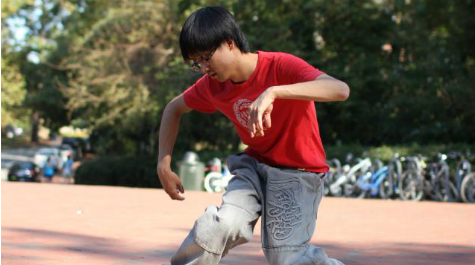Breaking internationally
The history of breakdancing is most often associated with New York hip-hop culture, not that of Guangzhou, China. But Qi Chen, a computer science exchange student from the University of Adelaide, will be the first to trumpet the connection. Chen has been a member of William & Mary’s Bboy (breakdancing) Club since his arrival on campus for the Spring 2012 semester.
“Every chance I get, I just go out dancing,” said Chen. “Bboy Club is great because it fits my freestyle way of dancing.”
After watching a television program featuring Elmo, the famous Taiwanese breakdancer, Chen knew he had found an art form that spoke directly to his soul. It was the first time he had seen any form of hip-hop culture, and he was amazed.
“After seeing Elmo, I became more aware of kids dancing in my high school and breakdancing crews throughout Guangzhou.”
According to Chen, breakdancing is extremely popular in China and his high school had several crews of breakdancers. Chen is also quick to point out that it has become popular throughout Asia, especially in South Korea, Taiwan and Japan.
“Breakdancing is more popular in Asia than it is in the United States,” asserted Chen. “There are more organized and individual competitions, and people doing it, than anywhere else in the world.”
Before Chen found W&M’s Bboy Club, he tried out several other student dance groups, but found his style of dance ill-suited to the more choreographically focused groups. He had even noticed flyers for the W&M Bboy Club around campus, but by then was discouraged and skeptical that he would be a good fit for that organization either.
It wasn’t until Chen read an article in The Flat Hat, W&M’s student newspaper, that he attended a meeting. He discovered that the Bboy Club is dedicated to teaching breakdancing and promoting hip-hop history and culture, providing a wonderful opportunity to further hone his dancing.
“Joining the Bboy Club has been great,” said Chen. “Not only have I been able to continue dancing, but I’ve also learned more about the culture of hip-hop and the historical context of breakdancing.”
Chen quick established a name for himself within the club, becoming the only “locker” in the group. “Locking” involves continuous movement, linking one move to the next. Chen defines it as a style of hip-hop dance that originated in California, “a dance based on funky music that’s so much fun to watch.”
At the end of the Fall 2012 semester, Chen returned to the University of Adelaide after a year of exchange at William & Mary. Although he will miss his breakdancing compatriots in the W&M Bboy Club, he is looking forward to exploring Adelaide’s hip-hop scene and continuing to express himself through break dancing.
“I’ll keep dancing,” Chen promised. “It’s a way of life.”















